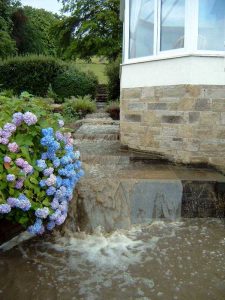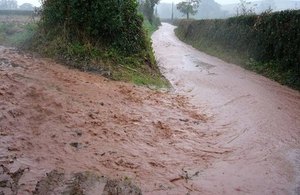Picture the scene, it’s raining, like really raining. You are looking out of your window watching water cascade down the road and starting to form a puddle in your driveway.
That puddle is getting big.
The rain is still falling, and you notice that gully outside is looking pretty full…then the manhole pops. You glance back to the puddle; it is still getting bigger and now it is slowly inching towards your house.
You watch as the water comes towards your front door, then down the driveway at the side. It feels like your house is quickly becoming an island. More water is coming. You look out of the window and notice thankfully the level seems to have stopped rising…but how?
You look out of the back window and notice that the water is flooding down the steps into your garden, it’s a big garden, with a big lawn and you are relieved to realise that there is lots of space for the water to be stored.
OK, so the garden is looking more like a swimming pool but that can be fixed, at least it is not flooding your house.
What you have just witnessed is called an exceedance pathway.

This week as we continue to look at some of the requirements in the pre-planning stage we will be taking a look at exceedance planning exploring what it is, why we need it and what it looks like.
So, what is exceedance planning?
Exceedance planning, which is now often required as part of planning applications is the process engineers go through to determine where water will go should a drainage system become overloaded.
The main aim is to get water away from properties or habitable dwellings and instead allow it to be temporarily stored before feeding back into the system later.
Surely this means that the drainage engineer has got his calcs wrong?
Most definitely not.
When designing a drainage system, even when the engineer does everything right, systems can fail. Drainage exceedance will occur when the amount of surface water that needs to be drained is greater than the capacity of the system. This could be because of poor maintenance resulting in blockages, the drainage being damaged or as a result of an extreme rainfall event.
Typically, sewers need to be designed to so that no flooding occurs for the 1 in 30-year rainfall event. Generally, it is not sustainable or economical to design drainage systems to accommodate more extreme events and the last thing anyone wants when a system does become over capacitated is for the water to start flooding into a property. It is therefore often preferable to permit flooding of open spaces such as car parks, landscaped areas or in the example above a back garden.
So, when is it needed?
An exceedance strategy is now often required as part of the planning process, however, as a general rule of thumb, the sooner you think about where water will go in an extreme rainfall event the better, and, you should definitely be developing your site layout to accommodate this.
There have been many examples of where layouts have been developed with buildings at the lowest part of the site which has resulted in either a costly redesign or a requirement to retrofit drainage in to ensure that the building doesn’t flood.

What does an exceedance strategy look like?
The exceedance strategy is usually dictated by the topography of the site and is often presented within the planning package as a separate drawing. The drawing typically uses blue arrows to show the direction of flow of any water and it will need to illustrate that it will bypass any buildings and that it can be contained on the site, i.e. not pose a flood risk elsewhere.
Drainage Engineers will often run simulations within drainage software which will help them determine the flow routes and identify where the system is likely to fail.
Want to know more?
There is loads of great information and guidance available some of which I have listed below:
- CIRIA guidance C635 Designing for exceedance which can be downloaded for free (https://www.ciria.org/ItemDetail?iProductCode=C635F&Category=FREEPUBS)
- Susdrain website (https://www.susdrain.org/delivering-suds/drainage-exceedance/background/background.html).
Or if you really want to get your geek on, why not check out this great little webinar brought to you by the Team at Innovyze (https://www.innovyze.com/en-us/campaigns/emea-on-demand-webinar-designing-for-overland-flow-and-exceedance-routes-in-microdrainage).
Failing that, you could always get in touch with one of our friendly drainage engineers here at Rennard Consulting who will be more than happy to discuss your project in more detail.